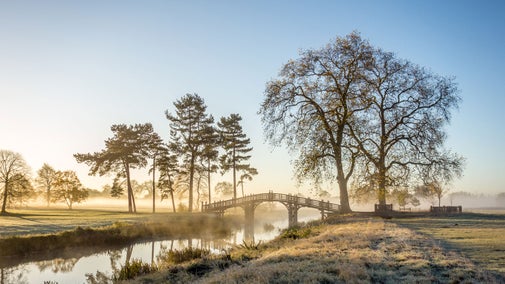
Donate
Everyone needs nature, now more than ever. Donate today and you could help people and nature to thrive at the places we care for.

A specialist volunteer team saved 16 metres of Middle Litteleton Tithe Barn's dry stone walls from collapse. Find out about the project and the volunteers who used their expertise and time to rebuild the walls.
In early 2013, the warden at St Nicholas Church, our neighbour at the Middle Littleton Tithe Barn, contacted the National Trust advising that the wall between the church and the orchard adjacent to the barn was in a bad state of repair. The wall is jointly owned by the church and the National Trust, but the church didn’t have the resources to make the repair and asked if we could help.
One of our skilled volunteers, Pete, went to assess what needed doing. Upon finding the wall was overgrown with brambles and damaged by trees he arranged for the garden and park volunteers from nearby Croome to clear away the undergrowth, while Hugh Warwick and Justin Fozard (Croome’s Area Ranger and Gardener respectively) removed the trees.

This enabled a proper assessment, and it was found that there were 16 metres of collapsed or partially collapsed wall that needed rebuilding. The damage was in part caused by the church gravediggers, who had piled up earth from the graves along the wall on the church side, causing ingress of water.
The wall is made of a hard limestone, which is local to North Evesham, and is unusual in that it is wider than a normal wall. It is not thought to be contemporary with the construction of either the church or the tithe barn, but was instead a later addition. The wall is double width because of a local ‘rule’ that both landowners are responsible for the party wall. The quarries that the stone would have originally come from are no longer active; luckily, we were able to rebuild the wall with the existing stone.
In June 2013, work started in earnest to rebuild the wall. A team of volunteers worked Wednesdays and Saturdays in varying combinations to get the job done.
The Croome garden volunteers also spent several Tuesdays working on the wall, developing new skills and helping the walling team with this large project. Work finished in August 2013 and the team returned to Croome to continue work behind the Park Seat. A total of 350 hours were spent restoring the wall to its former condition.

The volunteer walling team, based at Croome, was founded when Pete retired and decided to find something to do outdoors. Pete took a couple of college courses and learned the skills of stone-walling and hedge-laying, and it was the latter that brought him to Croome in 2012. Whilst involved in this work, Pete became aware of the state of some of the walls and approached Croome’s Garden and Park Manager, with an offer to help repair them.
Pete’s work was examined by the Building Surveyor for National Trust Midlands, and he received approval to work on the boundary wall at the back of the Park Seat at Croome.
This began what went on to become the volunteer dry stone walling team, which now has six regular members who work primarily on Fridays and welcome visitors, volunteers and staff to come and talk to them.
With your ongoing support, we're able to continue our vital conservation work. Thank you for helping to protect these special places.

Everyone needs nature, now more than ever. Donate today and you could help people and nature to thrive at the places we care for.

Discover Middle Littleton, one of the finest remaining tithe barns in the country. Dating to the 13th or 14th century, it's a unique building with a questioned past.

Expect the unexpected. Incredible innovation, devastating loss, remarkable survival and magnificent restoration all in one place.

Stretch your legs and take in winter scenes with far reaching views to the Malvern Hills across 'Capability' Brown's first major landscape design project.

Take a look at some of the conservation and restoration projects that have taken place in the estate at Croome.

We believe that nature, beauty and history are for everyone. That’s why we’re supporting wildlife, protecting historic sites and more. Find out about our work.

Read about our strategy, which focuses on restoring nature, ending unequal access and inspiring more people.